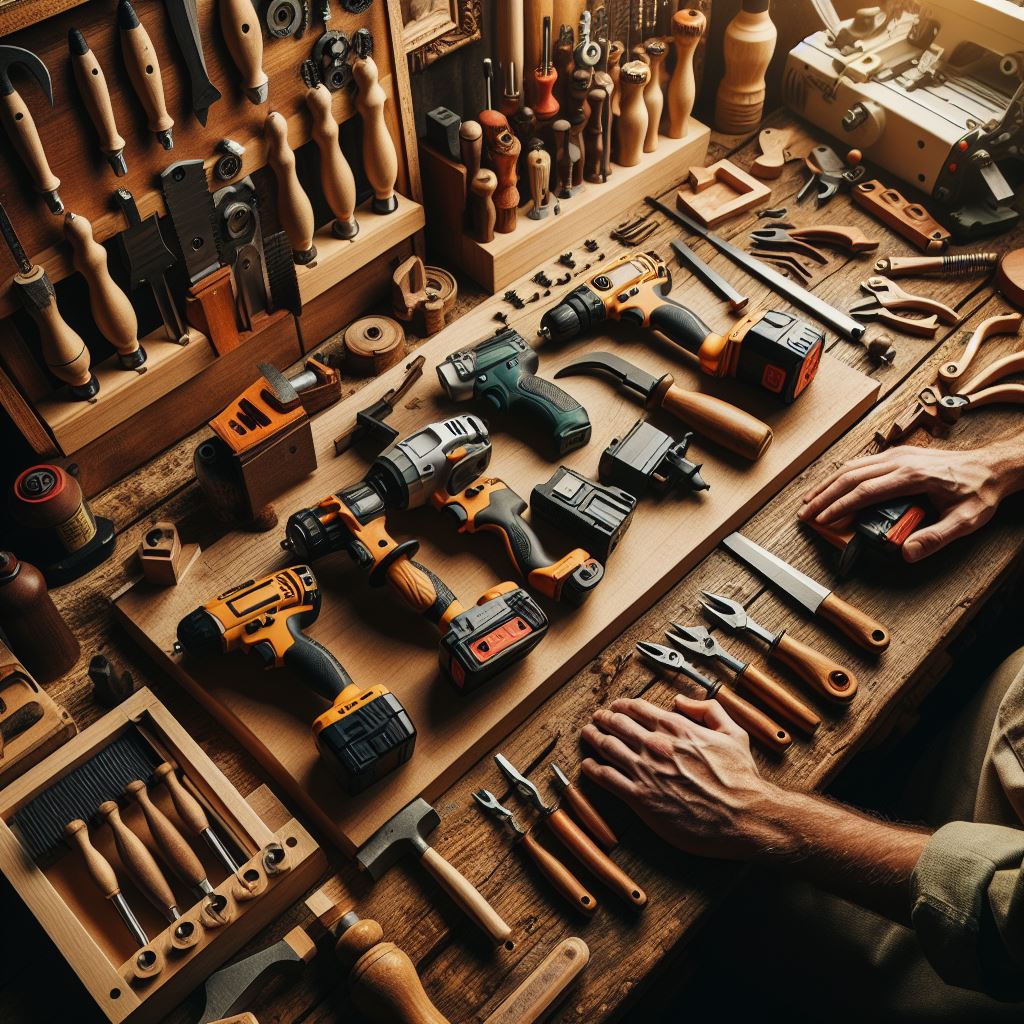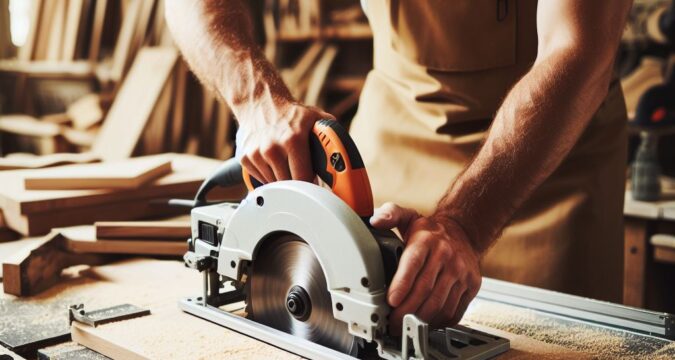
An Introduction to Power Tools for Woodworking
Ask any experienced woodworker, and they’ll tell you—power tools are essential for efficient and precise work. Whether you’re making intricate joints or sanding a tabletop smooth, power tools allow you to complete projects accurately and with less physical effort. This guide provides a comprehensive overview to get beginners started with power tools for woodworking.
| Takeaway | Summary |
|---|---|
| Types of Power Tools | Table saw, miter saw, jigsaw, orbital sander, belt sander, random orbital sander, drill, drill press, router |
| Choosing Power Tools | Depends on woodworking plans, budget, skill level. Starter kit: jigsaw, random orbital sander, cordless drill. Advanced: table saw, miter saw, router, cordless drill, orbital sander, biscuit joiner |
| Using Power Tools Safely | Follow all safety guidelines; wear protective gear, secure loose clothing/hair, use clamps and guides, don’t force tools |
| Power Tool Care | Keep clean and lubricated, store in a dry location, frequently inspect for damage, promptly replace worn parts |
| Buying Power Tools | New woodworkers: buy new for safety/reliability. Experienced: good used deals from sales/auctions |
| Learning Power Tools | Highly recommend beginner skills classes for coaching and hands-on practice before working independently |
Types of Power Tools for Woodworking
There are many types of power tools that woodworkers use:
Saws
Table Saw – A table saw has a circular blade mounted on an arbor that’s located beneath the surface of a table. It’s used for precise, repeatable cuts like ripping boards, crosscutting, miter cuts, bevels, and more. Table saws range from inexpensive portable models to professional cabinet saws.
Miter Saw – A power miter saw uses a circular blade mounted on a pivoting arm to cut material against a straight fence. This makes precise crosscuts and angled miters simple. Miter saws are considered more portable than table saws.
Jigsaw – A jigsaw has a thin, narrow blade that moves up and down to cut irregular curves and scrollwork. Many woodworkers keep one on hand for quick cutouts and decorative effects.

Sanders
Sanders smooth and shape wood surfaces. Common electric sanders include:
- Orbital Sanders – Great for quickly removing material and achieving a smooth surface.
- Belt Sanders – Have a continuous loop of sandpaper that’s ideal for shaping edges or smoothing large surfaces.
- Random Orbital Sanders – Provide a faster, swirl-free sanding motion. Easy to control.
Drills
Drills bore holes and drive screws. The two main types are:
- Cordless Drills – Compact, convenient and versatile. Allow driving screws as well as drilling holes.
- Drill Press – Benchtop machines that excel at drilling perfectly perpendicular holes. Helpful for detailed joinery work.
Routers
A versatile electric router has an adjustable cutting depth and uses a variety of shaped router bits for details like edge profiles, mortises, decorative effects and joinery.
Choosing Power Tools
Selecting power tools depends on your woodworking plans, budget and skill level.
Starter Tool Kit
Those new to woodworking may want to start with:
- Jigsaw
- Random orbital sander
- Cordless drill
These three are extremely versatile for smaller projects. Fancier tools can be added later as your skills progress.
Advanced Tool Collection
More experienced DIYers may be looking to equip a home workshop. Must-have power tools for passionate hobbyists include:
- Table saw
- Miter saw
- Router
- Cordless drill
- Orbital sander
- Biscuit joiner
Warning: Always follow power tool safety guidelines—protective eyewear, hearing protection, avoid loose clothing, and give your full attention. Small workshop injuries can quickly become serious accidents.
Using Power Tools Effectively
Let’s review safe handling techniques and example uses for common woodworking power tools:
Working with Saws
Table Saw: Use a push stick when ripping narrow boards. Never reach past the blade or remove safety guards. Stand to the side when cutting to avoid kickback injuries.
Miter Saw: Position your hands at least 6 inches from either side of the blade when cutting. Avoid awkward hand positions.
Jigsaw: Grip the tool firmly and brace your hands/arms to control the blade. Let the blade do the cutting, don’t force the jigsaw.
Sanding with Power Sanders
Always check sandpaper grits before sanding. Start coarser and work up to finer abrasives:
- 60-80 grit to remove saw marks
- 100-120 grit for general smoothing
- 150+ grit for final smoothing before finishing
Wear a dust mask, change sandpaper discs when loaded with dust and debris.
Drilling Pilot Holes
Drilling a smaller pilot hole prevents wood splitting when driving screws into hardwoods. Using a drill press ensures straight, true holes.
Cutting Edges with a Router
Routers excel at detail work like decorative edges. When free-hand routing, run the router base flat against a guide piece to safely follow a cut line.
Power Tool Care Tips
Taking proper care of power tools ensures safety and longevity:
- Keep tools clean and lightly lubricated
- Store in dry location to prevent rust
- Frequently inspect for damage
- Replace worn brushes and cables immediately
Be sure to unplug tools before changing accessories or adjustments. Basic care goes a long way to prevent headaches later!
Conclusion
Equipping a shop with power tools may require an initial investment, but the upgrade in woodworking capabilities is invaluable. Pay attention to safety procedures, research techniques and features before purchasing, and properly maintain tools. Patience and practice is key—start simple and have fun advancing your skills!
For more tips, check out these woodworking inspiration ideas.
Frequently Asked Questions
Should I buy power tools new or used?
We recommend most new woodworkers buy new tools. Amateur reconditioned tools have an unpredictable safety and reliability history. Once you gain experience, high-quality used tools are often great deals from estate sales, auctions, woodworking clubs or local ads.
How much do I need to spend on power tools?
The good news is that acceptable starter power tools can be purchased for less than $300. Expect to spend $500-1500+ as your capabilities expand. Budget choices exist in every price range and all levels deliver accurate, safe results with proper use.
Which brand should I buy?
Brands like DeWalt, Bosch, Festool, Makita and Ridgid have loyal followings for good reason. Craftsman and Ryobi offer very affordable options. Researching brands with high satisfaction ratings and long warranties is time well spent upfront.
Any good first power tool projects?
Definitely! Routers allow personalizing edges of shop projects like workbenches, tool storage and picture frames. Orbit sanders provide great practice on common jobs like sanding cut boards flat and smooth. Clamp some 2x pine and try your new jigsaw making curved designs.
How often do I need to replace power tool parts?
Depends on usage frequency and environment. Consumables like sandpaper, blades and batteries may need replacement every few months for heavy-use tools. Standard maintenance kits that include brushes, bearings and optional upgrades are worthwhile yearly for serious hobbyists.
Do I need a large workshop for power tools?
Not necessarily. Compact workshop designs are definitely possible for small-space woodworking. Key considerations are: adequate room for full woodstock/project dimensions, not crowding machine margins of safety, enough airflow and dust collection.
What’s the best way to learn using power tools?
We strongly recommend taking an in-person beginner skills class if available. Getting professional coaching and hands-on practice in a full workshop delivers confidence before working independently. Studying reputable DIY guides and videos supplements this nicely.
External Links
Skills Classes at WoodworkersClub.com

